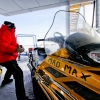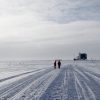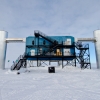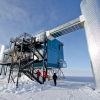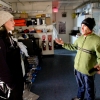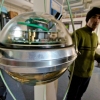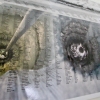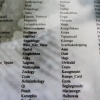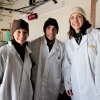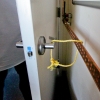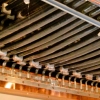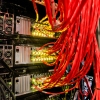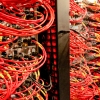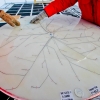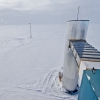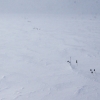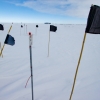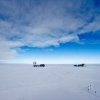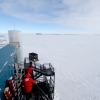CHAPTER 23
If you haven’t guessed it by now, one of the main perks of working at the South Pole, even as a dishwasher, is the opportunity to tour the many ground breaking scientific experiments taking place there- such as MAPO, the Greenhouse and SPT, which we have reported about previously. We had tried to take advantage of this situation as much as possible from the day we arrived, but the season slipped by quickly and before we knew it, our departure date was looming just a few weeks out. Realizing this, we decided to kick our sightseeing into high gear, and made plans to try and visit a new experiment every few days so that we could see them all before we left.
On this particular day we headed out to one of the craziest experiments of all- IceCube. Our scientist friend Carlos, who would be wintering over at the pole to monitor the IceCube project, kindly offered to give us a tour. I was doubly excited because he suggested we ride out to the lab on his trusty snowmobile, Mad Max (I haven’t ever ridden a snow mobile and thought the South Pole would be a fitting place for a first time). Unfortunately, Mad Max wasn’t being so trusty that day, and after a lot of fruitless pulling on the engine cord, we gave up and resigned ourselves to another long cold walk out to the Dark Sector.
The IceCube lab looks pretty much similar to the other science buildings on station- a big blue boxy building elevated off the ground that would look just as natural if it were on the moon. Ice cube, though, has a distinct difference from the other buildings: two giant silver towers flank the building on either side, giving it a satisfyingly symmetric appearance. When we finally got inside and out of our umpteen layers of cold weather gear, I asked Carlos about the towers. He was more than happy to enlighten us to the function of the towers and the whole experiment:
The idea behind IceCube is to observe a notoriously elusive sub-atomic particle: the neutrino. Neutrinos aren’t elusive because they are rare, indeed there are probably several billion zipping unnoticed through your body as you read this. That, in point of fact, is why they are so elusive: they don’t interact with normal matter most of the time, making them near impossible to detect, let alone observe. Once in a while though, a wayward neutrino will collide with a normal particle, say a proton or neutron, and during this violent collision a very small amount of light, quite literally the smallest you can get- 1 photon- will be given off. Now that we can detect. Yes, one photon doesn’t sound like much, you might miss it if you blink, but here is where an economy of scale comes into play. Even though neutrino collisions statistically never occur, since there are billions upon billions upon billions of them zipping through the entire earth every second, there are actually quite a few collisions taking place, though most of these occur deep in the earth, far from our ability to observe the single photon omitted in the collision. And here is when I tell you another amazing aspect of the South Pole…
We happen to be sitting on top of a two mile thick sheet of pure ice at the Pole, that is crystal clear, and pitch dark if you go down far enough. Any neutrino collisions happening here will surely be observable, if only you have a detector in place down in the ice to see the photons emitted in the collisions. Well that’s just what they have done. After drilling hundreds of wells deep into the ice with a specialized hot water jet, they lowered strings of basketball sized optical detectors called DOMS down into the holes and then filled the holes back up with water to freeze everything in place. The placement of the wells and the positions of the over 5,000 DOMS are such that a clear cube of ice, 1km on each side, has effectively been turned into a giant neutrino telescope. By analyzing the speed and direction of the photons released in the neutrino collisions with the ice molecules, the scientists can deduce a surprising amount of information about the mysterious particle, their source in the universe- be it the sun, a distant black hole, or some other crazy cosmic phenomena like a quasar or super-nova- and ultimately the nature and character of Dark Energy and Dark Matter.
Carlos gave us all a white lab coat to wear- I think just so we could pretend to be scientists- and then led us through a non-descript door into the brain of IceCube: a room filed floor to ceiling with racks of blinking electronics, all inter-connected with thousands of red wires. It gave me a headache just looking at it- I can’t imagine how complicated it must have been to connect them all correctly. As you might guess, it takes an amazing amount of computing power to run such a sophisticated experiment like this, with data coming in and being analyzed for the 5,000 DOMS all at the same time. The wires that connect to each of the DOMs travel up out of the wells, across the ice and up through the silver towers on the sides of the building into the lab, where they branch out into the rats nest of wires we saw in front of us. It would be Carlos’s job to monitor racks of computers and make sure they keep chugging away with their observations throughout the long cold winter.
With enough time and patience the scientists at IceCube should be able to collect enough data to nail down the neutrino and check off another unknown in the hunt for the Grand Unified Theory of Physics, as they like to call it. Again, the South Pole had proven itself to be invaluable to furthering our understanding of the universe. And yet again, we were amazed by our good fortune in being able to witness it all.
Prev ChapterNext Chapter


